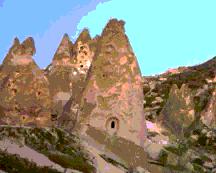Lycian language
When the Hittite Empire was dissolved, different small kingdoms and countries
took its place on vast lands of Anatolia. In the Western parts of the peninsula
Indo-European nations established several small states where the so-called
"late Anatolian languages" were spoken. Hittite
language turned into Lydian and Carian,
Luwian-speaking peoples were called Lycians,
Misians, Sydetians.
 Lycia
was a south-western part of the former Hittite region. The terrain of the
country was mountainous, and the hills and valleys were fertile. The country
was originally called Milyas and inhabited by the Solymi and the Termilae,
who were subjugated by the invading Lycians. The Lycians and the Greeks
first came into contact before the Trojan War in the 12st century BC, and
the remains of Lycian tombs, temples, and theaters show a marked Greek
influence. Lycia and Cilicia were the only two countries of Asia Minor
that were not conquered in the 6th century BC by Croesus, king of Lydia.
In the same century, however, the Lycians were defeated by the Persians
under King Cyrus the Great despite heroic resistance. Under the Persians,
Lycia remained prosperous and virtually autonomous. Along with the rest
of Asia Minor, Lycia was conquered by Alexander the Great of Macedonia
in the 4th century BC and incorporated into the Greco-Macedonian Empire.
Lycia
was a south-western part of the former Hittite region. The terrain of the
country was mountainous, and the hills and valleys were fertile. The country
was originally called Milyas and inhabited by the Solymi and the Termilae,
who were subjugated by the invading Lycians. The Lycians and the Greeks
first came into contact before the Trojan War in the 12st century BC, and
the remains of Lycian tombs, temples, and theaters show a marked Greek
influence. Lycia and Cilicia were the only two countries of Asia Minor
that were not conquered in the 6th century BC by Croesus, king of Lydia.
In the same century, however, the Lycians were defeated by the Persians
under King Cyrus the Great despite heroic resistance. Under the Persians,
Lycia remained prosperous and virtually autonomous. Along with the rest
of Asia Minor, Lycia was conquered by Alexander the Great of Macedonia
in the 4th century BC and incorporated into the Greco-Macedonian Empire.
Lycian language, being the late Luwian, nevertheless
developed some new features in its structure. Nasal vowels doubled the
number of vowels in the language, and this number was about thrice more
than in Luwian which had only 3 vowels. That
is why most endings of nouns and verbs have nasal vowels instead of the
"vowel + -n". The noun cases remained the same, as well as the verb
system (although researchers still argue about a strange -eni ending
in the 3rd person plural of verbs). Pronouns also changed slightly, though
Lycian declension of pronouns developed all similar features of "new" Anatolian
languages, including Lydian.
Still there are quite a few materials about Lycian, its grammar, and
its known glossary remains very poor. But Indo-European cognates, which
make about 20% in all Anatolian languages, still make Lycians' Indo-European
origin inevitable. Some time later we will surely place our Lycian grammar
in the Indo-European Grammars section.
 Lycia
was a south-western part of the former Hittite region. The terrain of the
country was mountainous, and the hills and valleys were fertile. The country
was originally called Milyas and inhabited by the Solymi and the Termilae,
who were subjugated by the invading Lycians. The Lycians and the Greeks
first came into contact before the Trojan War in the 12st century BC, and
the remains of Lycian tombs, temples, and theaters show a marked Greek
influence. Lycia and Cilicia were the only two countries of Asia Minor
that were not conquered in the 6th century BC by Croesus, king of Lydia.
In the same century, however, the Lycians were defeated by the Persians
under King Cyrus the Great despite heroic resistance. Under the Persians,
Lycia remained prosperous and virtually autonomous. Along with the rest
of Asia Minor, Lycia was conquered by Alexander the Great of Macedonia
in the 4th century BC and incorporated into the Greco-Macedonian Empire.
Lycia
was a south-western part of the former Hittite region. The terrain of the
country was mountainous, and the hills and valleys were fertile. The country
was originally called Milyas and inhabited by the Solymi and the Termilae,
who were subjugated by the invading Lycians. The Lycians and the Greeks
first came into contact before the Trojan War in the 12st century BC, and
the remains of Lycian tombs, temples, and theaters show a marked Greek
influence. Lycia and Cilicia were the only two countries of Asia Minor
that were not conquered in the 6th century BC by Croesus, king of Lydia.
In the same century, however, the Lycians were defeated by the Persians
under King Cyrus the Great despite heroic resistance. Under the Persians,
Lycia remained prosperous and virtually autonomous. Along with the rest
of Asia Minor, Lycia was conquered by Alexander the Great of Macedonia
in the 4th century BC and incorporated into the Greco-Macedonian Empire.